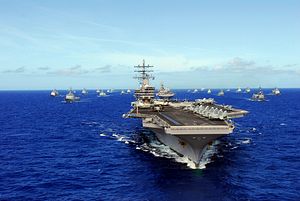As U.S. President Barack Obama enters his last year in office, it is increasingly clear that the so-called rebalance to the Asia-Pacific will be his administration’s major mark on U.S. policy toward the region. Four years after the rebalance was announced, however, a Congressionally mandated report found that there remains “consistent confusion about the rebalance strategy and concern about its implementation.”
The report, released this month by the Center for Strategic and International Studies (CSIS) and commissioned by the Department of Defense, found that the confusion was not limited to Asia-Pacific governments or the public, but rather extends throughout the U.S. government. Strikingly, the report points out that “there remains no central U.S. government document that describes the rebalance strategy and its associated elements.”
Since the moment the rebalance was announced, debate has flourished. Was it an unnecessary distraction from crises elsewhere, or an under-funded half-measure? Did it reassure allies and put China on notice, or has the administration over-promised and under-delivered? Whatever one’s views, it seems late in the game for outsiders to justifiably recommend the administration “develop and then articulate a clear and coherent strategy.”
Reading the CSIS report, which was directed by former officials from the Obama and George W. Bush administrations, one encounters a vision of Obama-era Asia policy as incoherent and weak, but not wrong-headed. The core message of the report is that, particularly in the military dimension, the U.S. needs to rebalance harder.
The authors begin from conventional assumptions that U.S. “core interests” in the Asia-Pacific are to “protect the security of the American people and U.S. allies,” to “expand trade and economic opportunity,” and to support “universal democratic norms.” They argue that “managing the rise of the Asia-Pacific will require a mix of engagement, deterrence, and reassurance,” and they explicitly reject “containment” vis-à-vis China.
Some of the report’s recommendations, however, might look like containment from a seat in Beijing or Hainan. Top-line recommendations include “strengthening ally and partner capability, capacity, resilience, and interoperability” and “sustaining and expanding U.S. military presence.” Further recommendations advocate for increased coordination and capacity among allies and partners in maritime Southeast Asia, and for increased U.S. funding to that end. Citing “China’s growing assertiveness,” they argue for increased U.S. surface fleet presence in the region. They advocate “combined operations” in intelligence, surveillance, and reconnaissance with treaty allies in the South and East China Seas.
The report is focused squarely on security concerns, to the almost total exclusion of U.S. economic and values interests cited at the outset, but this should be no surprise for a report commissioned by the Pentagon and required by Congress to address military issues in detail.
It is striking, however, that the report spends so little time imagining potential Chinese responses to the initiatives it advocates. The report does recommend the United States “expand confidence building and crisis management with China,” but it is seemingly unconcerned with the increased insecurity Chinese military and civilian officials might experience if U.S. and allied military efforts are significantly strengthened.
In a sense, this deficiency is a natural result of the conceptual slipperiness universally observed in the rebalance itself. Without what the CSIS authors call a “clear and coherent strategy,” defense experts will do what comes naturally and advocate for enhanced capabilities and effective deterrence. Part of the promise of the rebalance was to better integrate U.S. activities in defense, economic, and diplomatic realms, and in the diverse relationships the United States has with countries in the region.
When Obama announced in November 2011 that “the United States is turning our attention to the vast potential of the Asia-Pacific region,” observers reasonably expected a well-coordinated and -communicated set of priorities and policies.
In reality, it has been unclear how various U.S. initiatives and reactive measures in the region have related to one another, even if they were all framed in administration speeches as part of the same rebalance.
The calls for coherence in the CSIS report and in so many other contexts in recent years are really calls for a story we can tell ourselves about how U.S. policy efforts in the defense, economic, and diplomatic realms fit together and, ultimately, how they cope with the immense change and uncertainty emanating from China today.
The administration is realistically out of time to articulate a newly integrated vision and take actions that make it stick, though the president is required to produce “an overall strategy to promote United States interests in the Indo-Asia-Pacific region” by March 2017. If the Obama administration wants to sharpen its mark on Asia-Pacific policy, it should not punt this mandate to the new administration, but instead produce what so many have been waiting for since 2011.
Graham Webster (@gwbstr) is a researcher, lecturer, and senior fellow of The China Center at Yale Law School. Sign up for his free e-mail brief, U.S.–China Week.
































